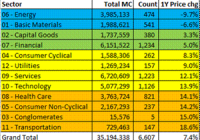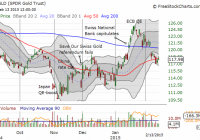ETF Deathwatch For August 2015: 330 And Climbing
Eleven ETFs and ETNs came off of ETF Deathwatch this month because they are no longer with us. Five more escaped because they were able to show a sustained improvement in their health, although the two iShares ETFs in this category are scheduled to close in August. Even with these sixteen departures, the overall list has four more members than last month. The reason for this growth is the twenty new names being added. The ETF Deathwatch for August consists of 330 products (240 ETFs and 90 ETNs). Historically, the number of ETFs and ETNs on Deathwatch have shown strong correlation to new ETF launch activity. The theory behind this is simple: a large number of new ETFs coming to market must compete against the other new products as well as the established base. Even the above-average performers may fail to attract attention, as investors find it more and more difficult to stay abreast of current offerings. As launch activity dwindles and overall ETF assets grow, many of the better products begin to take hold and weaker ones close, forcing the quantity of products on Deathwatch to decrease. As with many economic realities, it comes down to supply and demand. If this historical relationship holds, then I expect the size of the ETF Deathwatch list to continue growing in 2015 since launch activity is on pace to be the third strongest year ever. Meanwhile, closure activity is on pace to set a new record, and hundreds more are not profitable for their sponsors and should be closed. I expect the next large wave of additions to ETF Deathwatch will be many of the recently hatched currency-hedged ETFs. As detailed in ETF Stats for July 2015 – Currency Hedging Jumps The Shark , the quantity of currency-hedged ETFs surged from 16 to 57 since the beginning of 2014. By the time August comes to a close, the number will be even higher. I suspect many of these funds will find their way to Deathwatch due to either lack of investor awareness or lagging performance when the dollar rally fades. The average asset level of products on ETF Deathwatch decreased from $6.9 million to $6.8 million, but the quantity of products with less than $2 million in assets rose from 57 to 62. The average age fell from 50.3 months to 49.7 months, although the number of products more than five years old increased from 105 to 110. Here is the Complete List of 330 Products on ETF Deathwatch for August 2015 compiled using the objective ETF Deathwatch Criteria . The 20 ETPs added to ETF Deathwatch for August: ALPS Emerging Sector Dividend Dogs ETF (NYSEARCA: EDOG ) Arrow DWA Tactical ETF (NASDAQ: DWAT ) Deutsche X-trackers Muni Infrastructure Revenue Bond ETF (NYSEARCA: RVNU ) Direxion Daily FTSE Developed Markets Bull 1.25x (NYSEARCA: LLDM ) Direxion Daily FTSE Emerging Markets Bull 1.25x (NYSEARCA: LLEM ) Direxion Daily S&P 500 Bull 1.25x (NYSEARCA: LLSP ) Direxion Daily Small Cap Bull 1.25x (NYSEARCA: LLSC ) ETFS Diversified-Factor Developed Europe (NYSEARCA: SBEU ) ETFS Diversified-Factor U.S. Large Cap (NYSEARCA: SBUS ) ETFS Zacks Earnings Large-Cap U.S. (NYSEARCA: ZLRG ) ETFS Zacks Earnings Small-Cap U.S. (NYSEARCA: ZSML ) ETRACS Wells Fargo MLP Ex-Energy ETN (NYSEARCA: FMLP ) iPath US Treasury 2-year Bear ETN (NASDAQ: DTUS ) iShares Global Inflation-Linked Bond (NYSEARCA: GTIP ) iShares MSCI International Developed Momentum Factor (NYSEARCA: IMTM ) iShares MSCI International Developed Quality Factor (NYSEARCA: IQLT ) Master Income ETF (NYSEARCA: HIPS ) ProShares Managed Futures Strategy (NYSEARCA: FUTS ) QuantShares Hedged Dividend Income (NYSEARCA: DIVA ) SPDR Barclays International High Yield Bond (NYSEARCA: IJNK ) The 5 ETPs removed from ETF Deathwatch due to improved health: UBS ETRACS Monthly Pay 2x Leveraged S&P Dividend ETN (NYSEARCA: SDYL ) Guggenheim BulletShares 2022 HY Corp Bond (NYSEARCA: BSJM ) iShares MSCI Emerging Markets Value Index ETF (NASDAQ: EVAL ) iShares MSCI Hong Kong Small-Cap (NYSEARCA: EWHS ) PowerShares KBW Property & Casualty Insurance (PBWP) The 11 ETPs removed from ETF Deathwatch due to delisting: CS X-Links 2x Monthly Merger Arbitrage ETN (NYSEARCA: CSMB ) CS X-Links HOLT Market Neutral Global Equity ETN (NYSEARCA: CSMN ) RBS China Trendpilot ETN (NYSEARCA: TCHI ) RBS Global Big Pharma ETN (NYSEARCA: DRGS ) RBS Oil Trendpilot ETN (NYSEARCA: TWTI ) RBS Rogers Enhanced Agriculture ETN (NYSEARCA: RGRA ) RBS Rogers Enhanced Commodity Index ETN (NYSEARCA: RGRC ) RBS Rogers Enhanced Energy ETN (NYSEARCA: RGRE ) RBS Rogers Enhanced Industrial Metals ETN (NYSEARCA: RGRI ) RBS Rogers Enhanced Precious Metals ETN (NYSEARCA: RGRP ) RBS US Large Cap Alternator ETN (NYSEARCA: ALTL ) Disclosure: No positions in any of the securities mentioned. No positions in any of the companies or ETF sponsors mentioned. No income, revenue, or other compensation (either directly or indirectly) received from, or on behalf of, any of the companies or ETF sponsors mentioned. Share this article with a colleague

